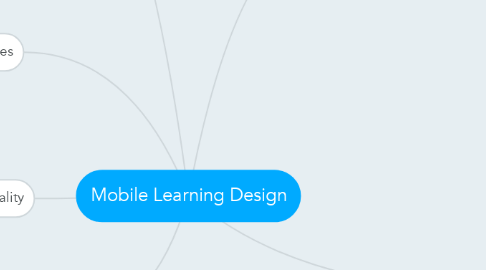
1. Multiple representations of reality
1.1. Produse (produce and consume knowledge)
2. Mobile Affordances
2.1. Augmenting
2.2. Capturing: audio, imagery or video
2.3. Communicating: two-way or group
2.4. Contextualising: iBeacons, QR, mobile tours etc.
2.5. eReading
2.6. Media playing
2.7. Notifications/Reminders
2.8. Memory/performance support: on-demand access to information
3. Theoretical Underpinning (Constructivist learning environments)
3.1. Knowledge construction (not reproduction)
3.2. Authentic tasks (rather than abstract instruction)
3.3. Real-world, case-based learning environments (rather than pre-determined instructional sequence)
3.4. context-dependent knowledge construction
3.5. collaborative construction of knowledge
4. Design Principles
4.1. Real-world relevance
4.2. Mobile context
4.3. Explore
4.4. Blended
4.5. Whenever
4.6. Wherever
4.7. Whomsoever
4.8. Affordances
4.9. Personalise
4.10. Mediation
5. Mobile Learning as Value-add
5.1. Key attributes of Mobile
5.1.1. Immediacy (anytime)
5.1.2. Ubiquity (anywhere)
5.1.3. Contextuality (in-situ)
5.2. Passive learning
5.2.1. Consume learning materials
5.2.1.1. Readings
5.2.1.2. Presentations
5.2.1.3. Videos
5.2.1.4. Podcasts
5.2.1.5. Posts
5.2.1.6. Learning objects
5.2.1.7. Quizzes
5.2.1.8. Images/infographics
5.3. Active learning
5.3.1. Construct learning artefacts
5.3.1.1. Written - essays, reports, surveys, journals
5.3.1.2. Verbal - oral presentations
5.3.1.3. Contextual - location-based
5.3.1.4. Visual - Drawings, figures, concept maps, infographs, animations/videos, portfolios
5.3.1.5. Multimodal - projects, experiential, concepting
5.3.2. Learn collaboratively
5.3.2.1. Group projects
5.3.2.2. Group discussions
5.3.2.3. Group sharing sessions
5.4. Connectivity
5.4.1. Video/Audio-conferencing
5.4.2. Messaging
5.4.3. Social networking
5.5. Expectations associated with mLearning
5.5.1. Non-linear
5.5.2. Immediate
5.5.3. Small-sized/Modular
5.5.4. Flexibility
5.5.5. Ownership

